Reduced Graphene Oxide Embedded with MQ Silicone Resin Nano-Aggregates for Silicone Rubber Composites with Enhanced Thermal Conductivity and Mechanical Performance
Abstract
1. Introduction
2. Materials and Methods
2.1. Materials
2.2. Synthesis of RGO
2.3. Synthesis of MQ
2.4. Synthesis of RGO/MQ
2.5. Preparation of RGO/MQ/SRComposites
2.6. Characterization
3. Results and Discussion
3.1. Morphology and Structure of the RGO/MQ
3.2. Morphology of the RGO/MQ/SR Composites
3.3. Thermal Conductivity of the RGO/MQ/SR Composites
3.4. Mechanical Properties of the RGO/MQ/SR Composites
4. Conclusions
Author Contributions
Funding
Conflicts of Interest
References
- Eduok, U.; Faye, D.; Szpunar, J. Recent developments and applications of protective silicone coatings: A review of PDMS functional materials. Prog. Org. Coat. 2017, 111, 124–163. [Google Scholar] [CrossRef]
- Shit, S.C.; Shah, P. A review on silicone rubber. Natl. Acad. Sci. Lett. 2013, 36, 355–365. [Google Scholar] [CrossRef]
- Zhang, Y. Preparation of high-temperature silicone rubber mold and its application in food industry. Adv. J. Food Sci. Technol. 2016, 12, 145–149. [Google Scholar] [CrossRef]
- Li, X.; Zhang, D.; Chen, Y. Silicone rubber/hollow silica spheres composites with enhanced mechanical and electrical insulating performances. Mater. Lett. 2017, 205, 240–244. [Google Scholar] [CrossRef]
- Wåhlander, M.; Nilsson, F.; Andersson, R.L.; Sanchez, C.C.; Taylor, N.; Carlmark, A.; Hillborg, H.; Malmström, E. Tailoring dielectric properties using designed polymer-grafted ZnO nanoparticles in silicone rubber. J. Mater. Chem. A 2017, 5, 14241–14258. [Google Scholar] [CrossRef]
- Gao, B.; Xu, J.; Peng, J.; Kang, F.; Du, H.; Li, J.; Chiang, S.W.; Xu, C.; Hu, N.; Ning, X. Experimental and theoretical studies of effective thermal conductivity of composites made of silicone rubber and Al2O3 particles. Thermochim. Acta 2015, 614, 1–8. [Google Scholar] [CrossRef]
- Namitha, L.K.; Ananthakumar, S.; Sebastian, M.T. Aluminum nitride filled flexible silicone rubber composites for microwave substrate applications. J. Mater. Sci. Mater. Electron. 2015, 26, 891–897. [Google Scholar] [CrossRef]
- Zhang, Y.; Zeng, X.; Lai, X.; Li, H. Preparation of functionalized zirconium phosphate and its effect on the flame retardancy of silicone rubber. RSC Adv. 2018, 8, 111–121. [Google Scholar] [CrossRef]
- Xiao, W.; Lei, Y.; Xia, Z.; Chen, X.; Han, Y.; Nie, J. Effect of silver plating time on the properties of conductive silicone rubber filled with silver-coated carbonyl nickel powder. J. Alloys Compd. 2017, 724, 24–28. [Google Scholar] [CrossRef]
- Lou, F.; Cheng, L.; Li, Q.; Wei, T.; Guan, X.; Guo, W. The combination of glass dust and glass fiber as fluxing agents for ceramifiable silicone rubber composites. RSC Adv. 2017, 7, 38805–38811. [Google Scholar] [CrossRef]
- Ziraki, S.; Zebarjad, S.M.; Hadianfard, M.J. A study on the tensile properties of silicone rubber/polypropylene fibers/silica hybrid nanocomposites. J. Mech. Behav. Biomed. Mater. 2016, 57, 289–296. [Google Scholar] [CrossRef] [PubMed]
- Ji, T.; Feng, Y.; Qin, M.; Li, S.; Zhang, F.; Lv, F.; Feng, W. Thermal conductive and flexible silastic composite based on a hierarchical framework of aligned carbon fibers-carbon nanotubes. Carbon 2018, 131, 149–159. [Google Scholar] [CrossRef]
- Novoselov, K.S.; Geim, A.K.; Morozov, S.V.; Jiang, D.; Zhang, Y.; Dubonos, S.V.; Grigorieva, I.V.; Firsov, A.A. Electric field effect in atomically thin carbon films. Science 2004, 306, 666–669. [Google Scholar] [CrossRef] [PubMed]
- Sreenivasulu, B.; Ramji, B.R.; Nagaral, M. A review on graphene reinforced polymer matrix composites. Mater. Today 2018, 5, 2419–2428. [Google Scholar] [CrossRef]
- Geim, A.K.; Novoselov, K.S. The rise of graphene. Nat. Mater. 2007, 6, 183–190. [Google Scholar] [CrossRef] [PubMed]
- Boland, C.S.; Khan, U.; Ryan, G.; Barwich, S.; Charifou, R.; Harvey, A.; Backes, C.; Li, Z.; Ferreira, M.S.; Möbius, M.E.; et al. Sensitive electromechanical sensors using viscoelastic graphene-polymer nanocomposites. Science 2016, 354, 1257–1260. [Google Scholar] [CrossRef] [PubMed]
- Song, J.; Chen, C.; Zhang, Y. High thermal conductivity and stretchability of layer-by-layer assembled silicone rubber/graphene nanosheets multilayered films. Compos. Part A Appl. Sci. Manuf. 2018, 105, 1–8. [Google Scholar] [CrossRef]
- Chen, C.; Pu, N.; Liu, Y.; Chen, L.; Wu, C.; Cheng, T.; Lin, M.; Ger, M.; Gong, Y.; Peng, Y.; et al. Microwave absorption properties of holey graphene/silicone rubber composites. Compos. Part B Eng. 2018, 135, 119–128. [Google Scholar] [CrossRef]
- Tian, L.; Wang, Y.; Li, Z.; Mei, H.; Shang, Y. The thermal conductivity-dependant drag reduction mechanism of water droplets controlled by graphene/silicone rubber composites. Exp. Therm. Fluid Sci. 2017, 85, 363–369. [Google Scholar] [CrossRef]
- Xu, H.; Gong, L.; Wang, X.; Zhao, L.; Pei, Y.; Wang, G.; Liu, Y.; Wu, L.; Jiang, J.; Tang, L. Influence of processing conditions on dispersion, electrical and mechanical properties of graphene-filled-silicone rubber composites. Compos. Part A Appl. Sci. Manuf. 2016, 91, 53–64. [Google Scholar] [CrossRef]
- Flagg, D.H.; Mccarthy, T.J. Rediscovering silicones: MQ copolymers. Macromolecules 2016, 49, 8581–8592. [Google Scholar] [CrossRef]
- Zhang, Y.; Zeng, X.; Lai, X.; Li, H.; Zhou, Q.; Huang, X. Suppression effect and mechanism of amine-containing MQ silicone resin on the tracking and erosion resistance of silicone rubber. ACS Omega 2017, 2, 5111–5121. [Google Scholar] [CrossRef]
- Fang, W.; Zeng, X.; Lai, X.; Li, H.; Xie, C.; Chen, W.; Zhang, Y. Investigation of the tracking and erosion resistance of cured liquid silicone rubber containing ureido-modified MQ silicone resin. IEEE Trans. Dielectr. Electr. Insul. 2017, 23, 3668–3675. [Google Scholar] [CrossRef]
- Di, M.; He, S.; Li, R.; Yang, D. Radiation effect of 150 keV protons on methyl silicone rubber reinforced with MQ silicone resin. Nucl. Instrum. Methods Phys. Res. Sect. B Beam Interact. Mater. Atoms 2006, 248, 31–36. [Google Scholar] [CrossRef]
- Chen, D.; Chen, F.; Hu, X.; Zhang, H.; Yin, X.; Zhou, Y. Thermal stability, mechanical and optical properties of novel addition cured PDMS composites with nano-silica sol and MQ silicone resin. Compos. Sci. Technol. 2015, 117, 307–314. [Google Scholar] [CrossRef]
- Xiang, H.; Ge, J.; Cheng, S.; Han, H.; Cui, S. Synthesis and characterization of titania/MQ silicone resin hybrid nanocomposite via sol–gel process. J. Sol–Gel Sci. Technol. 2011, 59, 635–639. [Google Scholar] [CrossRef]
- Zhao, T.; Jin, W.; Wang, Y.; Ji, X.; Yan, H.; Khan, M.; Jiang, Y.; Dang, A.; Li, H.; Li, T. Facile synthesis of graphene nanosheets via barium ferrite assisted intercalation and secondary expansion of graphite. Mater. Lett. 2018, 212, 1–3. [Google Scholar] [CrossRef]
- Shang, Y.; Li, T.; Yin, Y.; Li, H.; Dang, A.; Zhang, L.; Chen, X.; Zhang, Y.; Xiong, C.; Zhao, T. Effect of the graphene derived from thermal reduction within matrix on the performance of graphene/poly (methyl methacrylate) composites. J. Anal. Appl. Pyrolysis 2016, 120, 215–221. [Google Scholar] [CrossRef]
- Shang, Y.; Li, T.; Zhu, X.; Zhang, Y.; Chen, X.; Zhao, T. Effect of the graphene sheets derived from multistep oxidized carbon nanotubes on the performance of graphene sheets/poly(methyl methacrylate) composites. J. Anal. Appl. Pyrolysis 2015, 114, 243–249. [Google Scholar] [CrossRef]
- Guirgis, G.A.; Shens, Z.; Qtaitat, M.A.; Durig, J.R. Spectra and structure of silicon containing compounds: XXIII 1. Raman and infrared spectra, conformational stability, vibrational assignment and ab initio calculations of dimethyl vinyl chlorosilane. J. Mol. Struct. 1997, 403, 57–71. [Google Scholar] [CrossRef]
- Shang, Y.; Li, T.; Li, H.; Dang, A.; Zhang, L.; Yin, Y.; Xiong, C.; Zhao, T. Preparation and characterization of graphene derived from low-temperature and pressure promoted thermal reduction. Compos. Part B Eng. 2016, 99, 106–111. [Google Scholar] [CrossRef]
- Li, R.; Zhang, B.; Liu, B.; Chen, X.; Wang, G. Structure and Properties of Poly(Diphenylsiloxane-Co-Dimethylsiloxane) Modified MQ Silicone Resin. Adv. Mater. Res. 2012, 496, 109–115. [Google Scholar] [CrossRef]
- Sun, F.; Hu, Y.; Du, H. Synthesis and characterization of MQ silicone resins. J. Appl. Polym. Sci. 2012, 125, 3532–3536. [Google Scholar] [CrossRef]
- Sanguri, V.; Dwivedi, D.K.; Singh, N.; Pandey, N.; Pandey, J.D. Thermodynamic properties of multicomponent systems and hole theory. J. Mol. Liq. 2008, 141, 1–7. [Google Scholar] [CrossRef]
- Song, Y.; Yu, J.; Yu, L.; Alam, F.E.; Dai, W.; Li, C.; Jiang, N. Enhancing the thermal, electrical, and mechanical properties of silicone rubber by addition of graphene nanoplatelets. Mater. Des. 2015, 88, 950–957. [Google Scholar] [CrossRef]
- Zong, Y.; Gui, D.; Li, S.; Tan, G.; Xiong, W.; Liu, J. Preparation and thermo-mechanical properties of functionalized graphene/silicone rubber nanocomposites. In Proceedings of the 2015 16th International Conference on Electronic Packaging Technology (ICEPT), Changsha, China, 11–14 August 2015; pp. 30–34. [Google Scholar]
- Xu, Y.; Gao, Q.; Liang, H.; Zheng, K. Effects of functional graphene oxide on the properties of phenyl silicone rubber composites. Polym. Test. 2016, 54, 168–175. [Google Scholar] [CrossRef]
- Tian, L.; Jin, E.; Mei, H.; Ke, Q.; Li, Z.; Kui, H. Bio-inspired graphene-enhanced thermally conductive elastic silicone rubber as drag reduction material. J. Bionic Eng. 2017, 14, 130–140. [Google Scholar] [CrossRef]
- Zhang, Y.; Yu, W.; Zhang, L.; Yin, J.; Wang, J.; Xie, H. Thermal conductivity and mechanical properties of low density silicone rubber filled with Al2O3 and graphene nanoplatelets. J. Therm. Sci. Eng. Appl. 2017, 10, 011014. [Google Scholar] [CrossRef]
- Ma, W.; Li, J.; Zhao, X. Improving the thermal and mechanical properties of silicone polymer by incorporating functionalized graphene oxide. J. Mater. Sci. 2013, 48, 5287–5294. [Google Scholar] [CrossRef]
- Shen, C.; Wang, H.; Zhang, T.; Zeng, Y. Silica coating onto graphene for improving thermal conductivity and electrical insulation of graphene/polydimethylsiloxane nanocomposites. J. Mater. Sci. Technol. 2019, 35, 36–43. [Google Scholar] [CrossRef]
- Qiu, X.; Cai, H.; Fang, X.; Zheng, J. The improved thermal oxidative stability of silicone rubber by incorporating reduced graphene oxide: Impact factors and action mechanism. Polym. Compos. 2018, 39, 1105–1115. [Google Scholar] [CrossRef]
- Wang, H.; Yang, C.; Liu, R.; Gong, K.; Hao, Q.; Wang, X.; Wu, J.; Zhang, G.; Hu, Y.; Jiang, J. Build a rigid–flexible graphene/silicone interface by embedding SiO2 for adhesive application. ACS Omega 2017, 2, 1063–1073. [Google Scholar] [CrossRef]
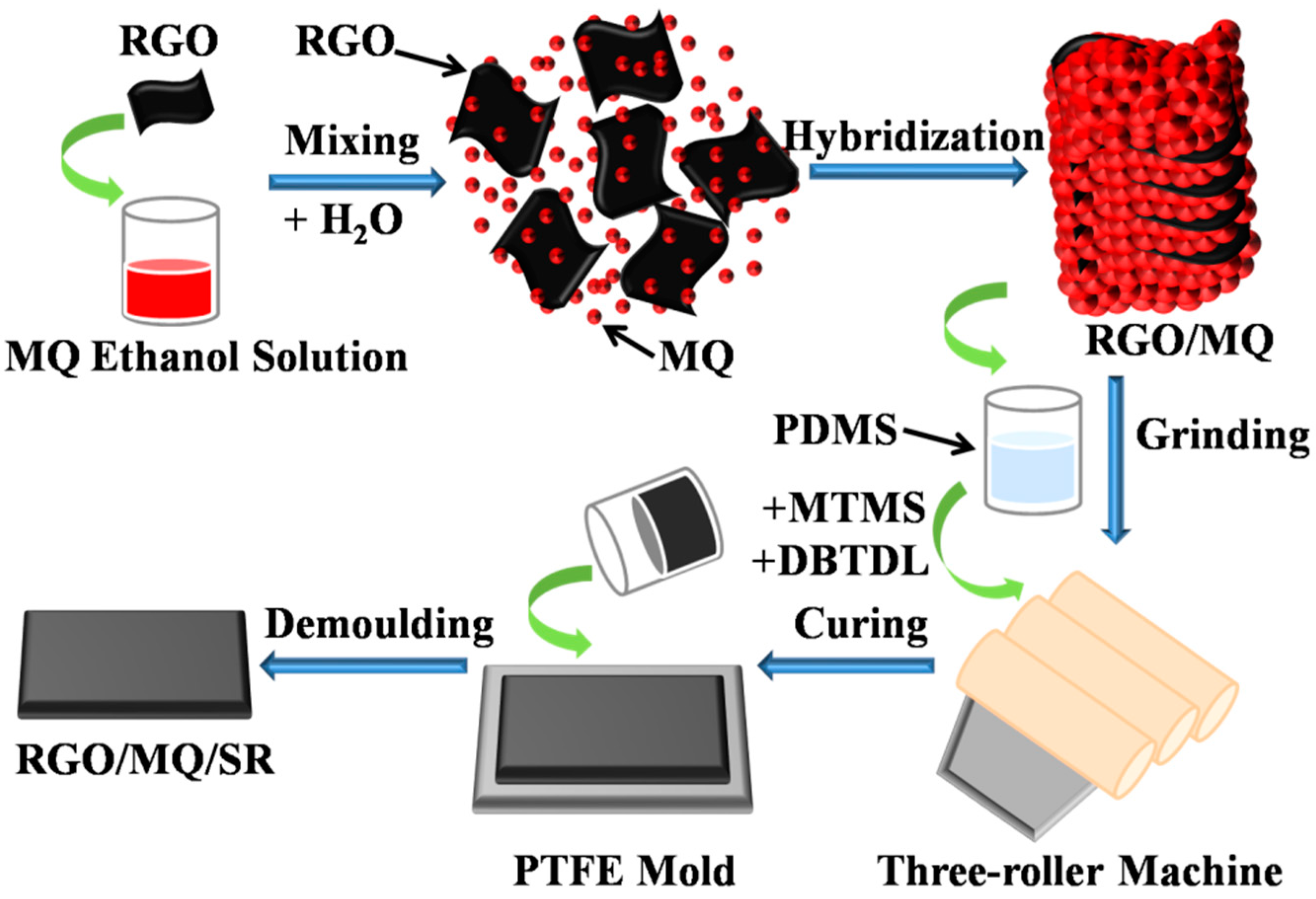
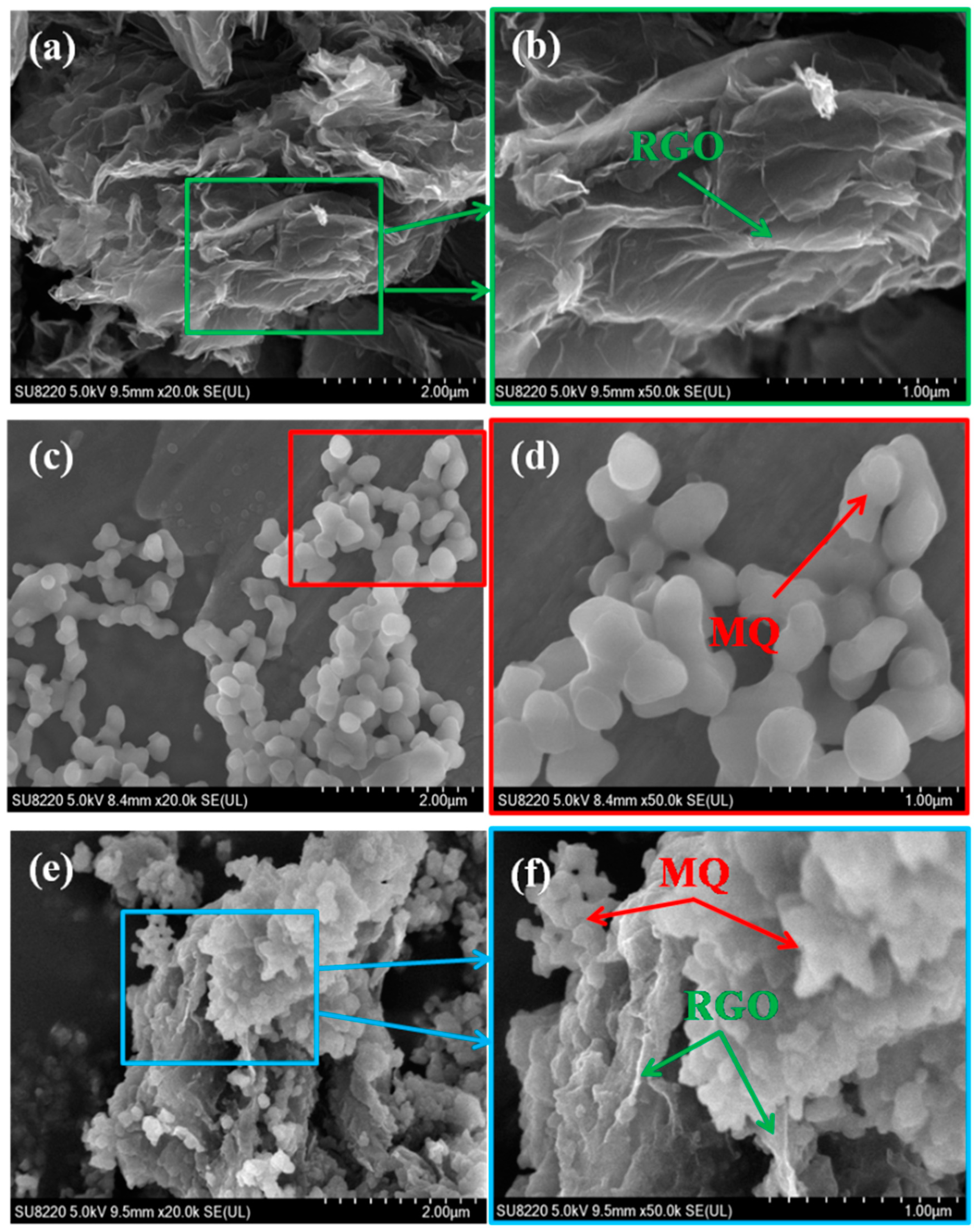

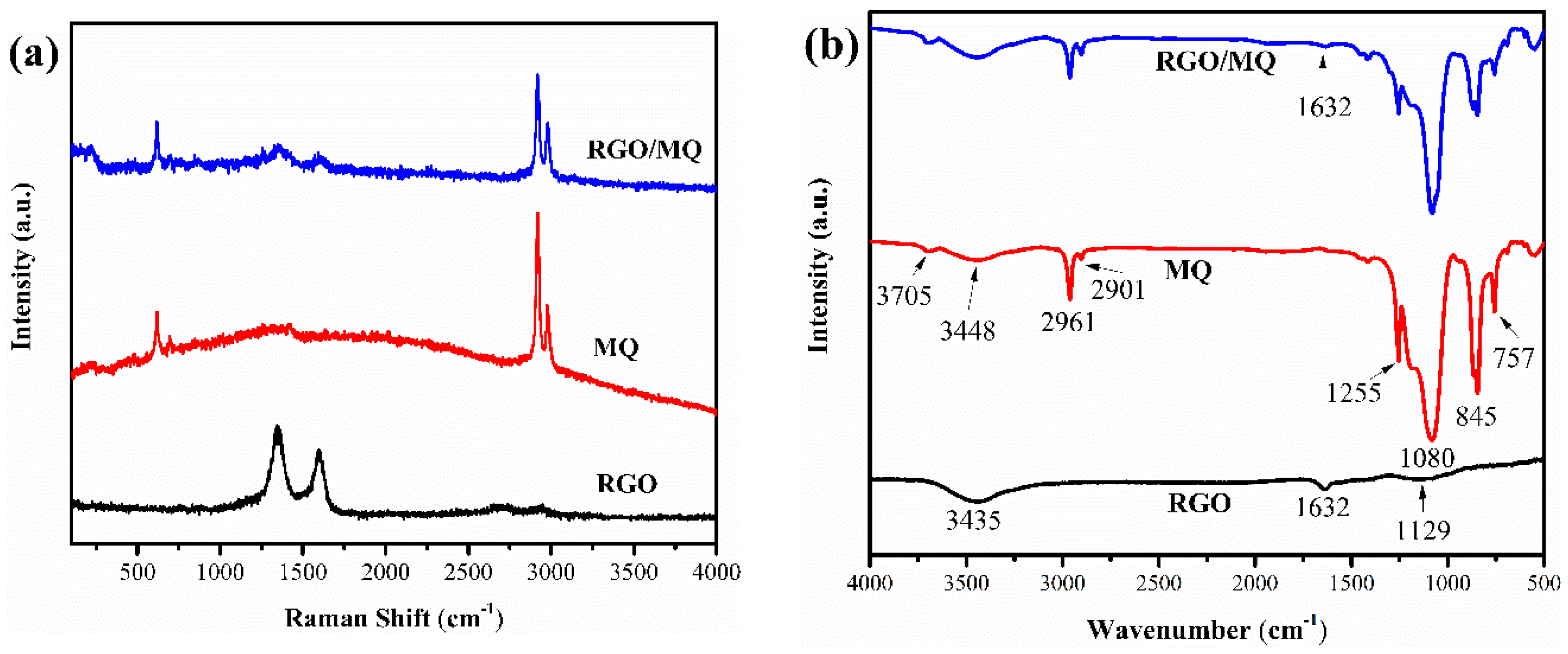


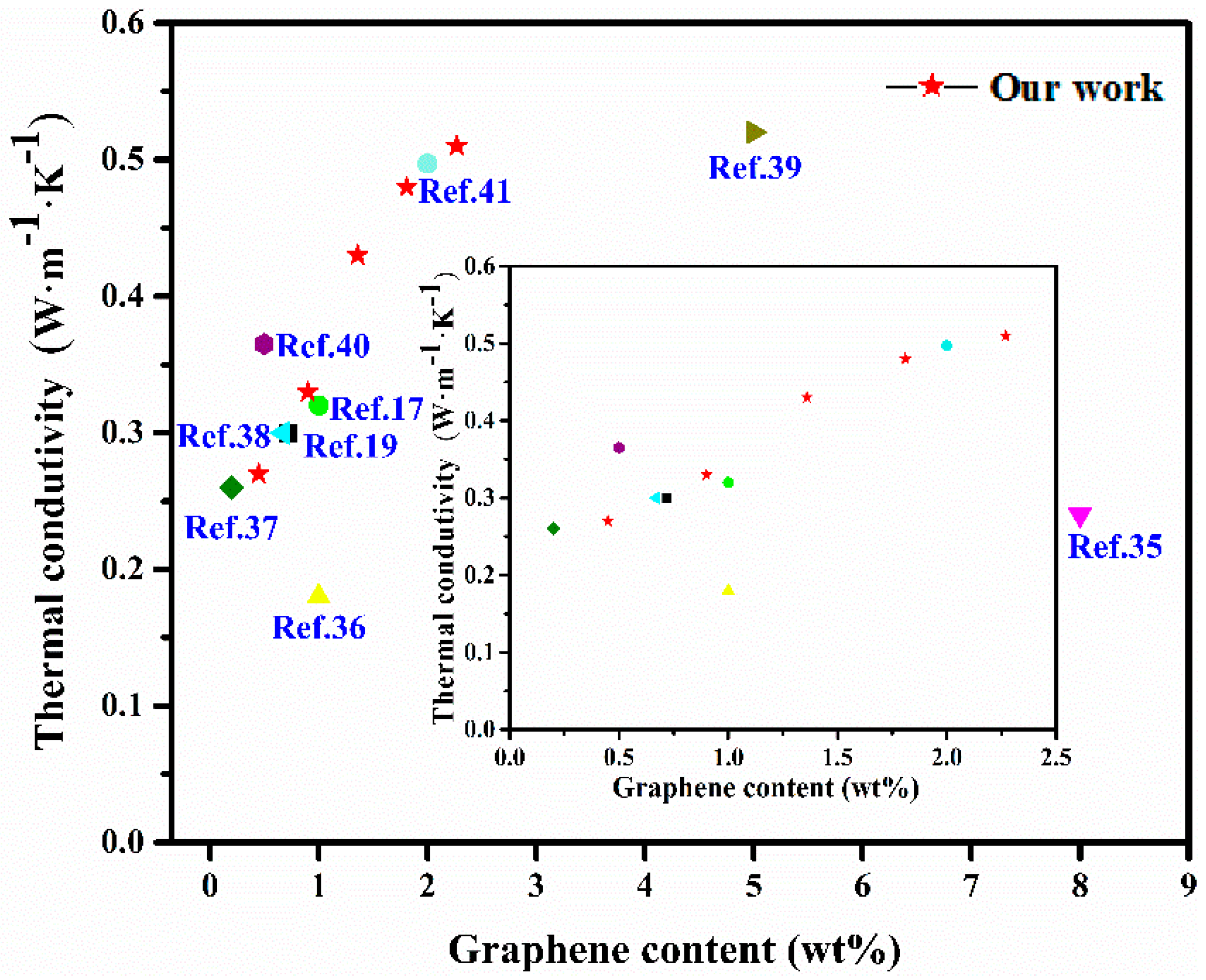

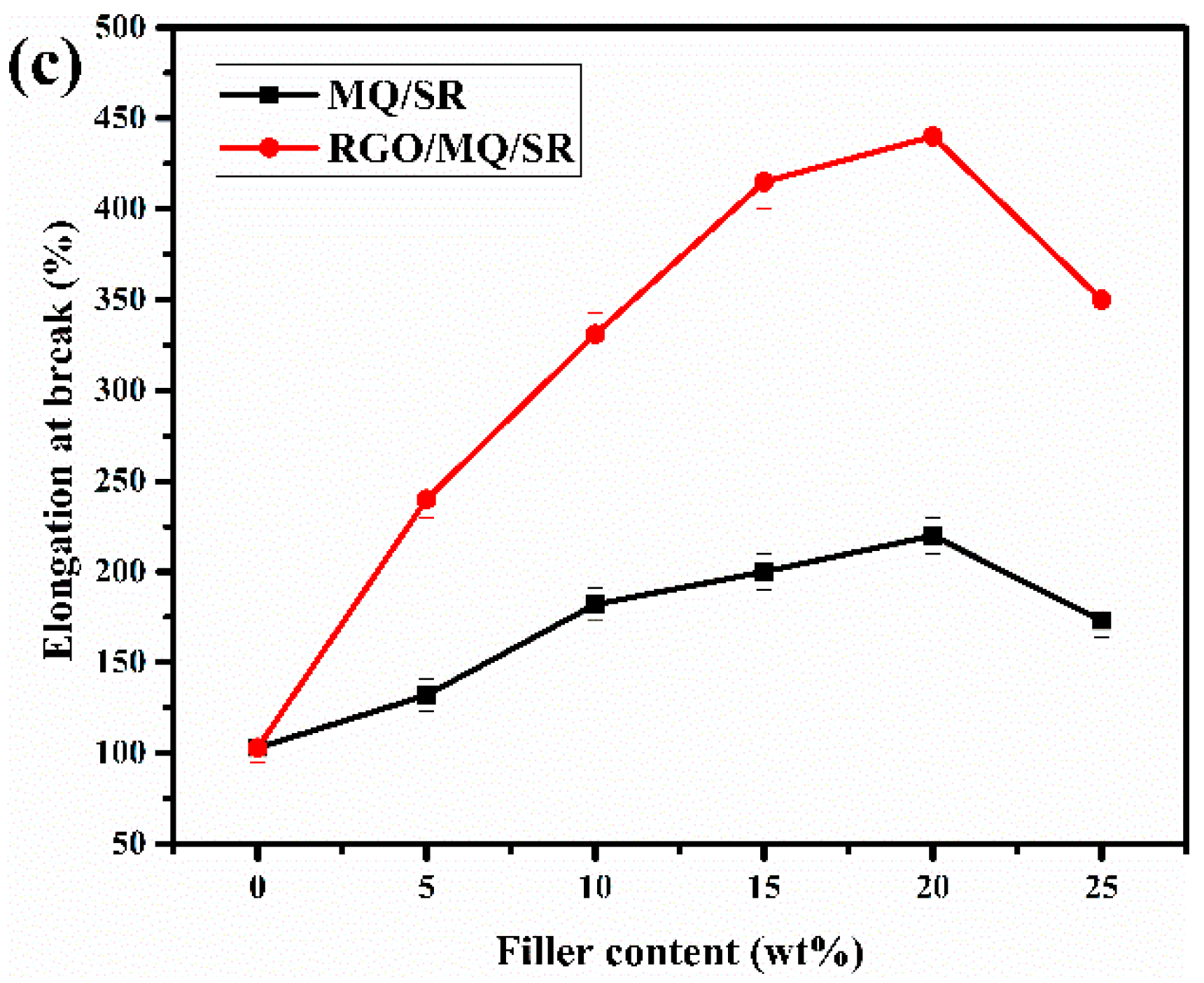
© 2018 by the authors. Licensee MDPI, Basel, Switzerland. This article is an open access article distributed under the terms and conditions of the Creative Commons Attribution (CC BY) license (http://creativecommons.org/licenses/by/4.0/).
Share and Cite
Liang, W.; Ge, X.; Ge, J.; Li, T.; Zhao, T.; Chen, X.; Song, Y.; Cui, Y.; Khan, M.; Ji, J.; et al. Reduced Graphene Oxide Embedded with MQ Silicone Resin Nano-Aggregates for Silicone Rubber Composites with Enhanced Thermal Conductivity and Mechanical Performance. Polymers 2018, 10, 1254. https://doi.org/10.3390/polym10111254
Liang W, Ge X, Ge J, Li T, Zhao T, Chen X, Song Y, Cui Y, Khan M, Ji J, et al. Reduced Graphene Oxide Embedded with MQ Silicone Resin Nano-Aggregates for Silicone Rubber Composites with Enhanced Thermal Conductivity and Mechanical Performance. Polymers. 2018; 10(11):1254. https://doi.org/10.3390/polym10111254
Chicago/Turabian StyleLiang, Weijie, Xin Ge, Jianfang Ge, Tiehu Li, Tingkai Zhao, Xunjun Chen, Yaozhen Song, Yingde Cui, Muhammad Khan, Jianye Ji, and et al. 2018. "Reduced Graphene Oxide Embedded with MQ Silicone Resin Nano-Aggregates for Silicone Rubber Composites with Enhanced Thermal Conductivity and Mechanical Performance" Polymers 10, no. 11: 1254. https://doi.org/10.3390/polym10111254
APA StyleLiang, W., Ge, X., Ge, J., Li, T., Zhao, T., Chen, X., Song, Y., Cui, Y., Khan, M., Ji, J., Pang, X., & Liu, R. (2018). Reduced Graphene Oxide Embedded with MQ Silicone Resin Nano-Aggregates for Silicone Rubber Composites with Enhanced Thermal Conductivity and Mechanical Performance. Polymers, 10(11), 1254. https://doi.org/10.3390/polym10111254




